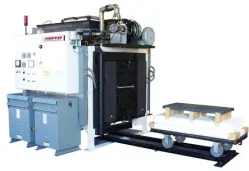Shuttle Kilns for ceramic membranes (SOFC)
Shuttle Kilns provide large volume batch processing for moderate to heavy loads, utilizing two or more cars or car trains to allow loading and unloading a setting while another set is being fired. Like its little brother the Envelope Kiln, the car arrangement allows rapid turn-around times from the end of a cycle to the start of the next cycle.
Unlike the Envelope Kiln, the Shuttle Kiln utilizes a fixed firing chamber and moves the load cars on leveled rail. This fact is the critical difference that allows a shuttle kiln to be constructed in virtually any size range needed, and to utilize insulation technologies ranging from low thermal mass ceramic fiber to ultra-high temperature or chemical resistant dense refractories that will not tolerate being moved repeatedly.
Applications:
- Ceramic Membranes – Solid Oxide Fuel Cells (SOFC) , Gas Separation, and Ultra-filtration
- Structural Ceramics – Ceramic Matrix Composites (CMC), Tile, Brick, Refractories, Metrology Standards
- Enameling – Cast Iron, Stampings, Tubs, Sinks, Pump Housings, Pipe
- Electrical Porcelain – High voltage insulators for the Power Transmission Industry
- Metals Heat Treating – Stress Relieving, Annealing, Billet Reheat, Forging Preheat
- Decorating, Glazing, Bisque Firing, Calcining, Sintering
- Multiple Processes in a Single Kiln – Debinding, Sintering, Glazing, Conditioning, Annealing
- Porcelain, Stoneware, Terra-Cotta, Architectural Ceramics
- Consumer Ceramics – Dinnerware, giftware, terra-cotta, home fixtures
General Capabilities:
- Temperatures to 3100°F (1700°C)
- Standard Designs from 36 to 1000 ft3 working volume but with virtually no upper limit on custom sizes
- Standard Setting lengths to 30 feet (9.14 meters) with larger custom lengths possible
- Electric heating for kilns with settings to 5 ft. (1.52 meters) wide
- Gas heating for kilns with cars to 6 ft. ( 1.83 meters) wide and the possibility of three or more car trains side by side in the kiln.
- Single or multiple control of heating and cooling zones
- Manual or Fully Automatic Firing Control






